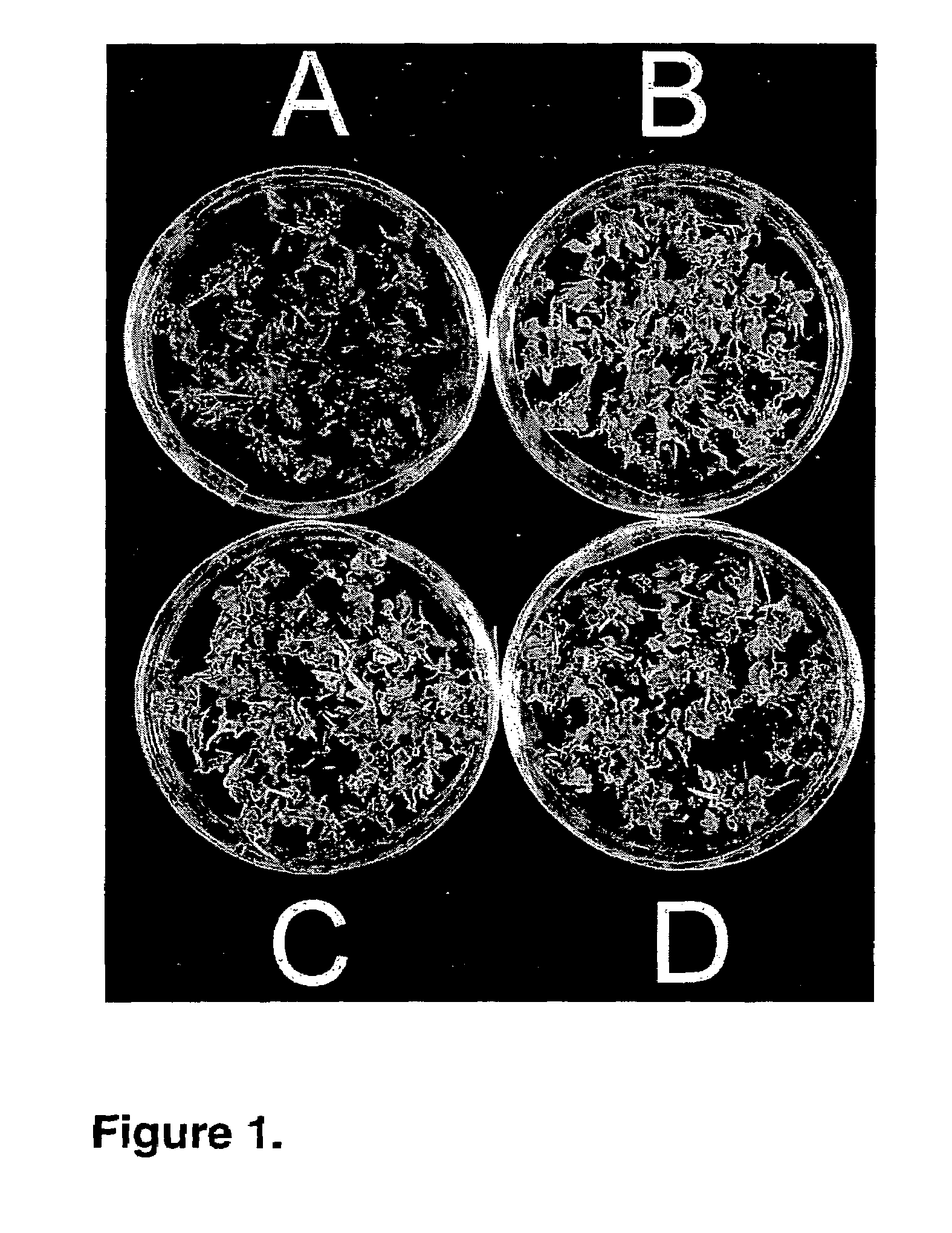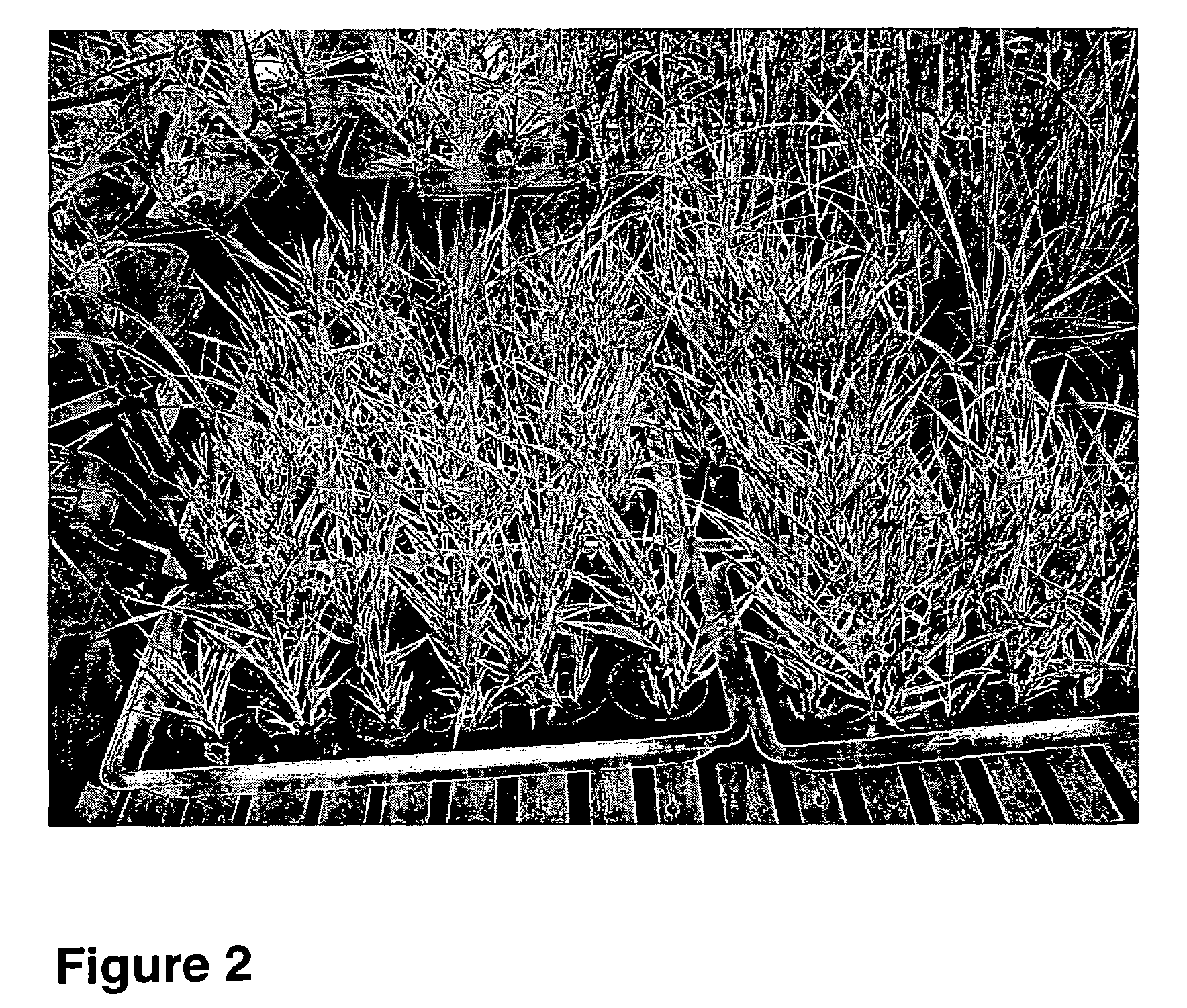Sustained totipotent culture of selected monocot genera
a monocot and culture technology, applied in sustainable biological treatment, biochemical apparatus and processes, biological water/sewage treatment, etc., can solve the problems of limited opportunity for genetic manipulation, sterility of plants, and rhizome division and traditional seed culture of giant reeds, so as to achieve less effort, less area, and less time
- Summary
- Abstract
- Description
- Claims
- Application Information
AI Technical Summary
Benefits of technology
Problems solved by technology
Method used
Image
Examples
example 1
[0059]This illustrates the formation of complete A. donax plantlets from excised tissue and shows the effect of different media upon shoot and root development.
[0060]Shoot tips bulging with developing inflorescences were collected from a large, naturalized patch of giant reed in the Southeastern United States in August. All but one of the leaf sheaths were stripped carefully so as not to expose the inflorescence. Shoot tips were disinfected by shaking in a solution of mercuric chloride plus 0.1% Tween 80 surfactant for 15 minutes. Shoot tips were rinsed three times with sterile water. The immature inflorescences were excised, chopped and placed on DM-8 or II1-S medium in the dark or under continuous illumination (30-50 μmol m−2s−1, composed of a mixture of incandescent and fluorescent tubes—Sylvania and Power Twist Vita-Lite 40 W) at 26° C. to 28° C.
[0061]Callus was cultured every four weeks for maintenance. Regenerated and rooted plants were separated, potted in the greenhouse, and...
example 2
[0077]This example illustrates the preparation of complete plantlets from excised A. donax cell tissue.
[0078]Shoot tips bulging with developing inflorescences were collected from a large, naturalized patch of giant reed. All but one leaf sheath were stripped carefully so as not to expose the inflorescence. Shoot tips were disinfected by shaking in a solution of 5 times diluted commercial bleach solution containing 10% (v / v) ethanol and 0.1% Tween 80 surfactant (w / v) for 15 min. Shoot tips were rinsed three times with sterile water.
[0079]The immature inflorescences were excised, chopped, and placed on the primary solid culture medium containing (in mg I−1, unless indicated otherwise) MS (Murashige and Skoog, 1975) basal salts (Sigma Fine Chemicals) 4,300 (which are nutrient salts); Miller's salt solution (6% [w / v] KH2PO4), 3 ml; myo-inositol, 100; Vitamix (Márton and Browse, 1991), 2 ml; sucrose, 30,000, supplemented with the plant growth regulators adenine, 80; 2,4-dichlorophenoxyac...
example 3
[0088]This example illustrates the transfer and expression of a heterologous gene into A. donax tissue by the present method.
[0089]Cross-sectional segment of immature A. donax inflorescence were prepared and cultivated as described in Example 2. The totipotent tissue was cocultivated with Agrobacterium tumefaciens carrying plasmid pMSF3022, which carried the bar gene for positive selection in plant cells. The gene confers resistance to the antibiotic / herbicide phosphinothricin.
[0090]Cocultivation was carried out in 6 ml. of liquid primary culture medium for four days in the dark at room temperature. Explants were then rinsed with liquid medium and placed on solid selective and non-selective control medium containing the antibiotic / herbicide phosphinothricine at 10 mg / l. All medium contained tidarcillin at 400 mg / l to eliminate residual A. tumefaciens. Controls include explants incubated without A. tumefaciens. The efficacy of the gene transfer (and proof of expression) can be seen i...
PUM
| Property | Measurement | Unit |
|---|---|---|
| concentration | aaaaa | aaaaa |
| diameter | aaaaa | aaaaa |
| height | aaaaa | aaaaa |
Abstract
Description
Claims
Application Information
 Login to View More
Login to View More - R&D
- Intellectual Property
- Life Sciences
- Materials
- Tech Scout
- Unparalleled Data Quality
- Higher Quality Content
- 60% Fewer Hallucinations
Browse by: Latest US Patents, China's latest patents, Technical Efficacy Thesaurus, Application Domain, Technology Topic, Popular Technical Reports.
© 2025 PatSnap. All rights reserved.Legal|Privacy policy|Modern Slavery Act Transparency Statement|Sitemap|About US| Contact US: help@patsnap.com



